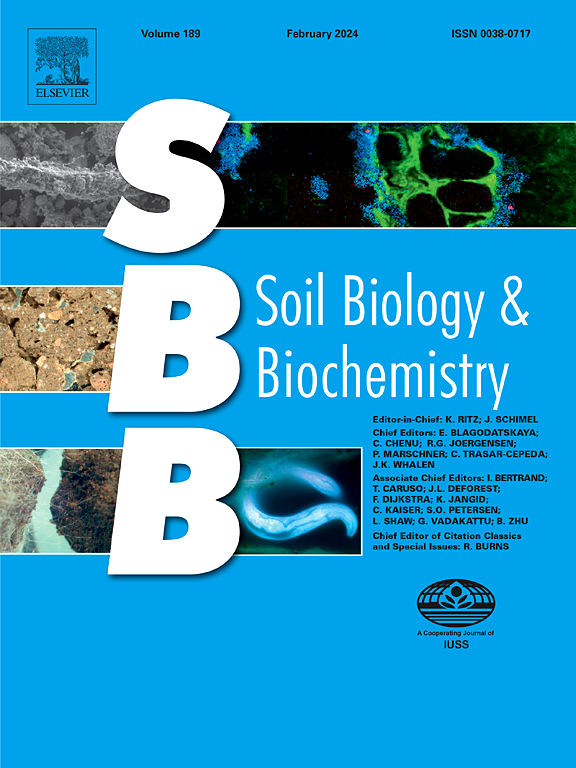Miscanthus litter additions induce a successional change in the soil micro-food web with apparent decreases in soil nitrogen
IF 10.3
1区 农林科学
Q1 SOIL SCIENCE
引用次数: 0
Abstract
The rapid loss of soil carbon (C) from cultivated peatland soils is leading to the use of high lignin, C-rich litter amendments as a potential solution to slow C losses. These chemically recalcitrant litter inputs are expected to cause microbial nitrogen (N) immobilization as a result of changes in the soil micro-food web, but whether bioavailable N is altered by litter as it is decomposed by the micro-food web remains unclear. We monitored changes in the soil nematode, fungal, and bacterial communities over time and across space (the rhizosphere and bulk soil) after field-applying different types of ligneous litter from miscanthus, ash, willow, or larch to a cultivated peatland soil. We found that miscanthus grass (C:N = 118) induced succession from fast-growing nematodes (cp-1) to slower-growing, cp-3 and cp-4 nematodes and this corresponded to reduced N availability. This lower soil N was likely due to relatively higher microbial biomass we observed with miscanthus, combined with a decrease in fast-growing bacterivores, limiting N mineralization from nematode grazing. We did not observe strong effects on the soil micro-food web or microbial biomass N for the other woody litters that had much higher C:N. This indicates that the changes in nematode community composition following ligneous litter inputs and subsequent impacts on soil N depend on litter type but are independent of litter C:N. Miscanthus amendments also corresponded to the lowest lettuce yield of all the amendments and thus caution is raised when using miscanthus straw as a widely-applied litter. Our results provide a useful reference to predict the effect of litter amendments on cultivated peatland soils through soil micro-food web dynamics, and bioavailable N for the crop.
添加马齿苋垃圾会引起土壤微观食物网的演替变化,导致土壤氮明显减少
由于泥炭耕地土壤中的土壤碳(C)迅速流失,人们开始使用高木质素、富含 C 的废弃物添加剂作为减缓碳流失的潜在解决方案。由于土壤微食物网的变化,预计这些化学难降解的废弃物会导致微生物固定氮(N),但废弃物在被微食物网分解时是否会改变生物可利用的氮仍不清楚。我们监测了土壤线虫、真菌和细菌群落在向耕作泥炭地土壤施用不同类型的鹅掌楸、白蜡、柳树或落叶松木质废弃物后,在不同时间和不同空间(根瘤菌层和大体积土壤)发生的变化。我们发现,马齿苋草(C:N = 118)诱导线虫从快速生长(cp-1)向慢速生长(cp-3 和 cp-4 线虫)演替,这与氮的可用性降低相对应。土壤氮含量降低的原因可能是,我们观察到马齿苋的微生物生物量相对较高,再加上快速生长的食菌体减少,限制了线虫捕食造成的氮矿化。我们没有观察到对土壤微观食物网或微生物生物量 N 有强烈影响的其他木质植被,它们的 C:N 要高得多。这表明,木质废弃物投入后线虫群落组成的变化以及随后对土壤氮的影响取决于废弃物类型,但与废弃物的 C:N 无关。在所有添加物中,马齿苋添加物的莴苣产量最低,因此在将马齿苋秸秆作为一种广泛应用的废弃物时需要谨慎。我们的研究结果为通过土壤微食物网动态和作物生物可利用氮来预测垃圾添加剂对泥炭地耕地土壤的影响提供了有用的参考。
本文章由计算机程序翻译,如有差异,请以英文原文为准。
求助全文
约1分钟内获得全文
求助全文
来源期刊

Soil Biology & Biochemistry
农林科学-土壤科学
CiteScore
16.90
自引率
9.30%
发文量
312
审稿时长
49 days
期刊介绍:
Soil Biology & Biochemistry publishes original research articles of international significance focusing on biological processes in soil and their applications to soil and environmental quality. Major topics include the ecology and biochemical processes of soil organisms, their effects on the environment, and interactions with plants. The journal also welcomes state-of-the-art reviews and discussions on contemporary research in soil biology and biochemistry.
 求助内容:
求助内容: 应助结果提醒方式:
应助结果提醒方式:


